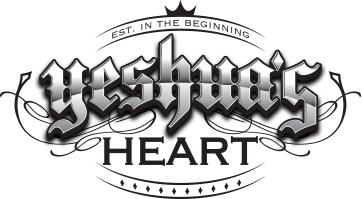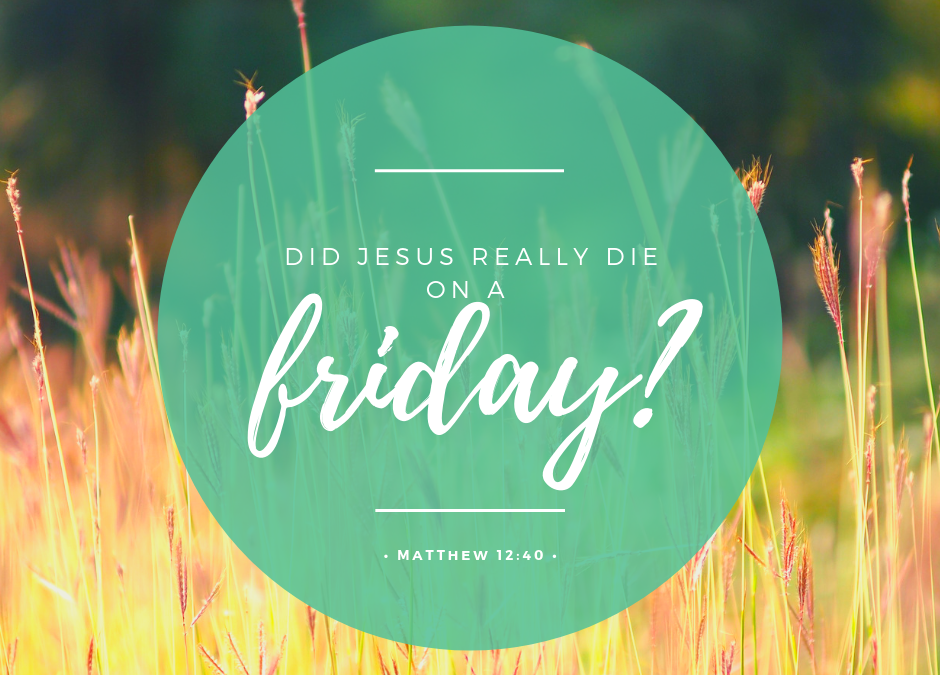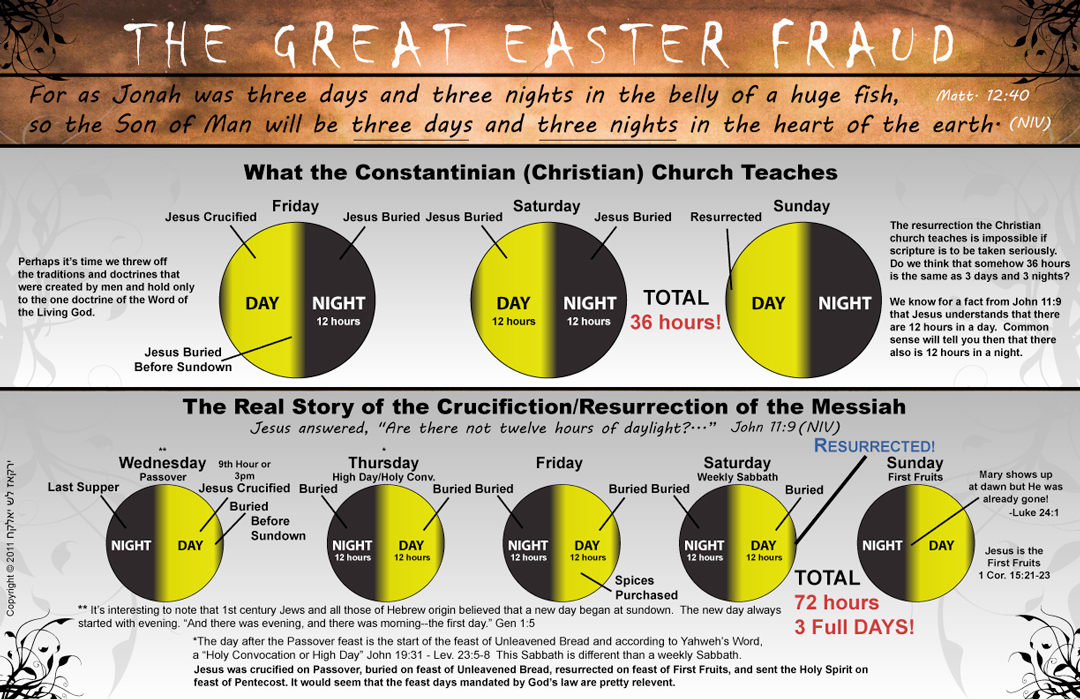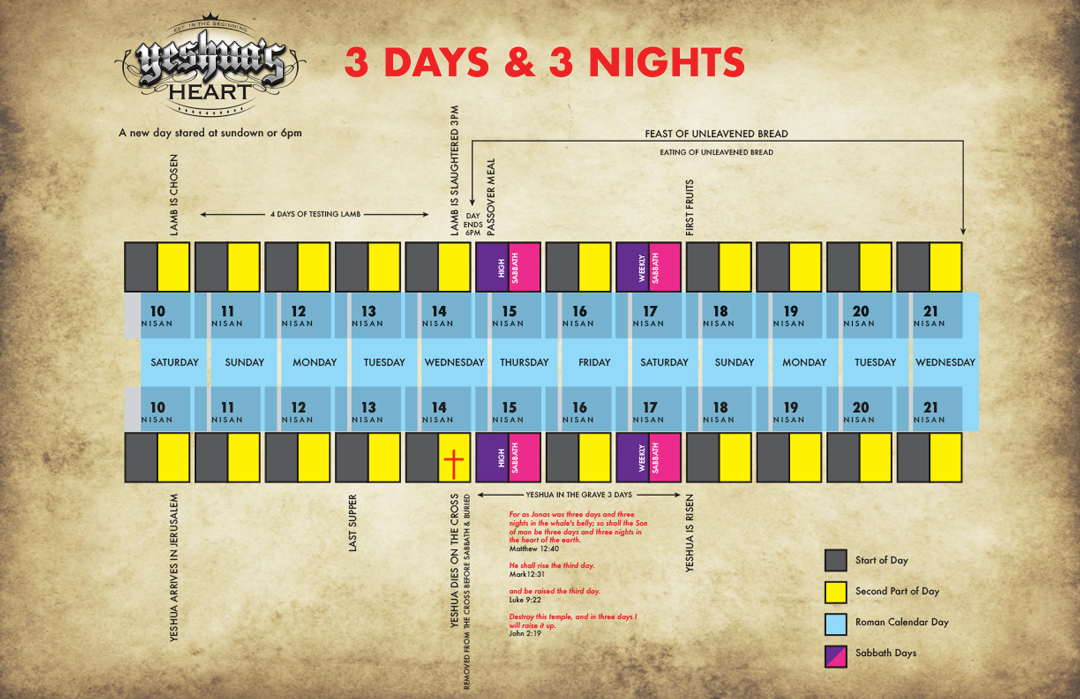Three Days and Three Nights, the sign of Messiah
Did Jesus (who’s Hebrew name is Yeshua) really die on a Friday? Why do Christian churches teach that Jesus dies on Friday and resurrects on Sunday?
One thing that always bothered me about Easter was that we know that the Messiah was prophesied about being in the ground three days and three nights. In fact it is the only major sign of his divinity that HE gave:
Matthew 12:40: “For as Jonas was three days and three nights in the whale’s belly; so shall the Son of man be three days and three nights in the heart of the earth.” (See Jonah 1:17)
God is not a God of confusion. He made clear what the length of a day and night are. He defined them in the beginning in Genesis and confirmed the hours in John 11: 9
“Yeshua answered, “Aren’t there twelve hours of daylight? If a person walks during daylight, he doesn’t stumble; because he sees the light of this world.”
Genesis 1:5 “And God called the light Day, and the darkness he called Night. And the evening and the morning were the first day.”
By this we can confirm that there are also 12 hours in the night to fulfill a 24 hour rotation. So 24 hours, 12 light and 12 dark is one full day. Therefore 72 hours is what is demanded from Messiah’s own lips and the prophesy of scripture.
Also notice that “evening and morning” was the first day. God defines a day as beginning in the dark and moving towards light. Sundown is when God considers a new day to begin. The Jews still keep this measure of daytime. In Hebrew, God’s calendar days are numbered, not named. The only day being named is the seventh day, Sabbath. Our Sunday is day one, Monday is day two and up to Friday which is day six.
The pagan custom of dying and being buried on Friday and rising on Sunday does not fit the 72 hour prophesy. Even if you take part of Friday, all of Saturday and part of Sunday, and erroneously count them as full “days” you still only have two nights. Not three. Therefore, if what the church says about Yeshua (Jesus) is true, dying and buried on Friday and rising on Sunday; then Yeshua (Jesus) is not the Messiah.
But we believe Yeshua of Nazareth IS messiah because he WAS in the ground three days and three nights. We know this because he died on a Wednesday, the day of Passover that year.
Passover always begins on the 14th day of the month of Nisan on God’s calendar, the following day is the first day of the Feast of Unleavened Bread, on the 15th of Nisan, and the Day of First Fruits is the first day after the weekly Sabbath during that festival. Leviticus 23:5,6
The weekly Sabbath is always on Saturday, therefore First Fruits is the first day after the weekly (Saturday) Sabbath of that festival week, which is Day 1 or Sunday. The first day of the feast of Unleavened Bread is also a Sabbath day of no work. It is usually called a High Sabbath or High Day to describe it as different from the weekly Sabbath.
When Yeshua was eating the final meal before his arrest and crucifixion, we see that it was not yet Passover, they were preparing for Passover. The KJV version *** erroneously translates “protos” as the “first day”. It is impossible for his disciples to be inquiring where to have the Passover seder on the first day of Unleavened Bread as Passover is always BEFORE Unleavened Bread.
Protos should more accurately be translated as “preparing” for the beginning of the feast of Passover and Unleavened Bread as it takes several days to prepare for it. There can be no bread with yeast [leaven] anywhere in the home. It is a type of spring cleaning that takes place for several days prior to Passover and Unleavened Bread, where the entire house is cleaned out to make sure there is no yeast. It still does to this day.
In addition, it is highly unlikely that the “bread” they broke had leaven in it. Firstly, because they were preparing for the feast of Unleavened Bread, and spring cleaning would already have occurred. Secondly, the leaven represents sin. Yeshua was sinless, so his symbolic body that was broken was sinless, therefore I believe it could have been unleavened matza and not a loaf of yeast risen bread.
What is also interesting is that it was a particular custom of Galileans for the first born son in every family to fast on Passover in thanksgiving for being spared by the Angel of Death. It is not a commandment to do so, but a tradition of Galilean Jews. Because the first born son was to fast on Passover, he traditionally had a large meal the day before. That final meal before the Passover fast was called…The Last Supper. Every first born son from the Galilee would have been partaking of this last supper the same night as Yeshua.
The day timeline is accurately portrayed in John 13:1,2: “Now before the Feast of the Passover, when Jesus knew that his hour had come to depart out of this world to the Father, having loved his own who were in the world, he loved them to the end. And supper being ended, the devil having now put into the heart of Judas Iscariot, Simon’s son, to betray him;”
The last meal was on Tuesday evening. After the meal, when Jesus told Judas to go and do what he must, we see “then it was night”. Remember that night begins the new day, therefore when it is Tuesday “night”, the Passover day had begun. According to temple custom, in a few hours when daylight appeared they would bind the Passover lamb to the altar and sacrifice it, at the same time they bound Yeshua to the cross and crucified him.
John 13:30: So, after receiving the morsel of bread, he immediately went out. And it was night.
This meant, Yeshua was in for a long night, since he would be crucified soon in the daylight hours of Passover day.
After the sun had set and they finished the meal, Yeshua went to the garden to pray. He was then arrested and faced Annas, Caiaphas, and the High Priest before Sunrise. We know this because it all took place before the cock crowed when Peter denied him the third time.
It is now early sunlight hours of Wednesday morning when Yeshua faces Pilate. He is then crucified. It is 9 am Wednesday, the “third hour of the day” on Passover.
The following day is a high Sabbath, the first day of the feast of Unleavened Bread.
The day before a Sabbath is always called preparation day. This is a day when you get all your business done and meals planned so you don’t have to do any work or heavy labor on Sabbath. That is why Yeshua had to be buried on prep day, before the high Sabbath of the first day of the feast of Unleavened Bread.
John 19:31: Since it was the day of Preparation, and so that the bodies would not remain on the cross on the Sabbath (for that Sabbath was a high day), the Jews asked Pilate that their legs might be broken and that they might be taken away.
Mary then visits the tomb early in the morning, before light on the first day of the week. The first day of the week is always Sunday. Again remember that after sundown on the weekly Sabbath, which is Saturday night, Mary could have gone up since Sabbath is over after sundown.
At any rate, it is still dark and Yeshua is already risen. If she came after sundown Saturday night while still dark, it would have been considered early Sunday, or the first day. So Yeshua had to have risen on Saturday as Mary would not have been able to come to the grave on Saturday during daylight as it was Sabbath.
So by this we know he is buried on Wednesday prior to sundown. In the grave Wednesday night, Thursday, Thursday night, Friday, Friday night and Saturday, being risen precisely at the same time Saturday late afternoon that he died on Wednesday 3 days prior.
Three days, Three nights…Messiah
Reprinted with permission from New 2 Torah




